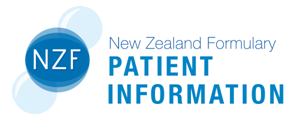What does it do?
Naratriptan is used to treat migraines.
Before you start
- Tell your health professional if you have heart or blood vessel problems, high blood pressure, or if you have ever had a stroke, or 'mini-stroke'.
- Tell your doctor if you are pregnant, planning to become pregnant, or breastfeeding.
How should you take it?
Take naratriptan as directed when your symptoms first start. Take with a large glass of water.
If your symptoms get better, but then return, you can take another dose after 4 hours.
If naratriptan does not help, do not take any further doses for the same attack, as it is unlikely to work. You can still use naratriptan for a new attack.
Do not take more than the maximum daily dose advised by your doctor.
Can you take other medicines?
Tell your pharmacist or doctor about all medicines or treatments that you may be taking, including vitamins, herbal products (e.g. St John's wort) or recreational drugs.
What side effects might you notice?
| Side Effects | Recommended action |
|---|---|
|
Pain, tightness or pressure in your chest, throat or jaw Fast or irregular heartbeat |
Tell your doctor immediately |
|
Drowsiness, tiredness or weakness, dizziness Hot flushing Burning sensation, tingling or numbness |
Tell your doctor if troublesome |
If you notice any other effects, discuss them with your doctor or pharmacist.
Other information:
- Tell your doctor if you need to use naratriptan several times each week. Using naratriptan too often can cause a different type of headache. Your doctor can talk with you about different medicines that are taken every day to prevent migraines.
- Do not use naratriptan to prevent migraines.
- Naratriptan can impair your ability to do tasks such as driving or using machines. Alcohol makes this worse. Discuss your risk with your health professional. (search NZTA - Are you safe to drive?)
This leaflet contains important, but not all, information about this medicine.
Prepared by the MyMedicines Committee at Christchurch Hospital, Te Whatu Ora - Waitaha, New Zealand. January 2024
For more general information about this sheet and its contents, see: What does a My Medicines sheet cover?
Te Reo Māori
Te Reo Māori information sheets supported by Health Quality and Safety Commission New Zealand
Web links for this sheet in different formats
Click on buttons to copy web addresses for this leaflet:
If your browser does not automatically copy these links use its copy command instead.
About My Medicines
My Medicines Patient Information Leaflets (PILs) contain important, but not all, information about the medicines they describe.
For more information about the sheets, see: What does a My Medicines sheet cover?
My Medicines is developed by a team at Te Whatu Ora – Waitaha. Our team is made up of doctors, pharmacists, and a non-medical person to help us keep to plain language. We also discuss our information with specialist health professionals or groups when needed

